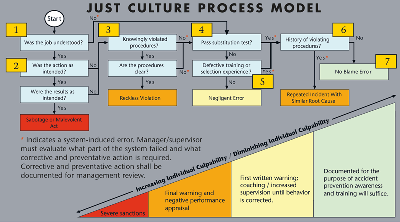You are having a peaceful afternoon in your office. Suddenly, your lead tech bursts in and tells you that the reference lab where an irretrievable specimen was sent last week called and said that the specimen was incorrectly prepared by your lab staff. The fluid leaked out before it got there, and the specimen has been seriously and permanently compromised.
What's your first reaction?
- Yell at the lead tech and tell her how incompetent her staff is.
- Remind the lead tech that this is not the first time that a specimen has been mishandled by her staff, but it better be the last.
- Pretend that you don't hear the lead tech and hope the situation will be addressed by someone else.
- Pretend that a clinician just called you and tell the lead tech you will get back to her. In the meantime, slip out the back door and take an early vacation.
If you felt tempted to pick one of these options, or even more than one, you are not alone.
 When confronted with staff errors, the better alternative for
lab directors is to remain calm so they can connect and collaborate.
When confronted with staff errors, the better alternative for
lab directors is to remain calm so they can connect and collaborate.
When confronted with staff errors, the better alternative for
lab directors is to remain calm so they can connect and collaborate.
Normal Human Response
Management experts Angie Morgan and Courtney Lynch, best-selling authors of the business book Leading From the Front (McGraw-Hill), remind us that the three human responses to stress are wired: fight, flight, or freeze. "Simply put, when placed under significant stress we as humans either attempt to fight though it, run away from it, or freeze and hope it goes away," they wrote. "While the human stress response has been instrumental to our survival as a species, it often complicates our work as leaders. Unfortunately, we can't just turn our stress response off, and we all have our default way of handling stress. Often, these reactionary tendencies to either fight, flee, or freeze will limit our ability to influence outcomes and inspire others."
Despite these innate tendencies, strong leaders should react differently, according to Morgan and Lynch. "Masterful leaders cultivate the self-awareness to recognize their default behavior under stress and choose a different approach. They choose the opposite of fight, flight, and freeze. They choose to calm, connect, and collaborate."
Choosing a Better Alternative
Morgan and Lynch offer these strategies for lab leaders to engage their calming, connecting, and collaborating selves.
Calm—Maintain your emotional resolve. Take a big long breath and calm yourself. It is very easy to lose perspective in these stressful moments. Ask yourself what just happened? Why did you react that way? What is really important to you right now?
Connect—Refocus on others' needs. To better understand what is really going on in the situation, put yourself in the shoes of those you are leading.
Collaborate—Leaders understand that collaboration during times of stress can be the motivating spark needed to push a team through adversity. Being present, both physically and mentally, in these circumstances will inspire the team's action.
Re-assessing the Situation
Let's take another look at that calm afternoon when you received the distressing news about the mishandled specimen. Following Morgan's and Lynch's advice, you resist the temptation for fight, flight, or freeze, and remember to use the Just Culture method to assess the situation (See Figure).
Was the job understood by all? I have never seen any processing person, phlebotomist, or medical technologist deliberately mishandle a specimen in my career. However, I have seen circumstances in which nurses, residents, or fellows at the collection point did not understand that the specimen had to be handled in a specific manner. For example, they may not have recognized that a specific collection device or specimen container must be used. This pre-analytical phase is generally out of the lab's control, but it is not out of the lab's zone of influence.
Did the person or persons who mishandled the specimen knowingly violate the standard operating procedure or process? In most cases, the answer is no.
Did this situation pass the so-called substitution test? In other words, could a similarly trained person, given the same set of circumstances, make the same mistake?
Many times, the answer is yes.
Did the person or persons who made the error have a history of violating procedures? In most cases, the answer is no.
Generally speaking, when lab leaders follow this assessment process, it becomes clear that the person who made the error was blame-free. The error most likely is a systems problem, so the system must be fixed. There is no need to affix blame on specific nurses, residents, fellows, phlebotomists, or medical technologists. As leaders in the lab, we need to fix the systems problem, not blame individuals.
 Excerpted from the January-February 2009 issue of Air Beat magazine and reprinted with permission from the Airborne Law Enforcement Association.
Excerpted from the January-February 2009 issue of Air Beat magazine and reprinted with permission from the Airborne Law Enforcement Association.
Going a Step Further
It is counterintuitive and relatively uncommon to thank the person who brought the error to your attention, as well as to ask that person what she thinks happened. In my experience, most people usually have a pretty good idea of what happened when they present the problem to their boss.
In these circumstances, it is important not to name the person who made the error since you have already determined that another similarly trained person could have made the same error. This is a learning situation. There is no need to throw anyone under the bus. With training in systems thinking and quality management, everyone can be deputized to solve systems problems.
Taking Action
When a similar situation happened recently in our laboratory, we asked the lead tech to work with the nursing staff where the error occurred. The goal was to communicate the need to have a special vial and to work with nursing to strengthen the procedure so that it would include the pre-analytical aspect of the collection. We used the Just Culture analysis for the nurses and showed them that the error occurred due to a systems problem. In this case, the contributing factors were misunderstandings on the part of the nurses and lack of clear instructions from the specimen processing area.
Both nursing and the lab processing team reviewed the revised procedure thoroughly, and everyone came to understand that this event was a classic hand-off error. After working together, both sides felt that communication had been enhanced and that the jointly developed procedure was clear to all. All the parties also felt that the chances of a recurrence of this error were markedly diminished.
In the end, we collected another specimen from the patient without any difficulties and obtained the results. No patient harm occurred, but it was certainly an instructive case for making our system safer. The clinician also sent a note of thanks for our having fixed the problem. He expressed his confidence in the lab and particularly noted how pleased he was that the laboratorians worked so closely with the nurses to solve the problem.
 James S. Hernandez, MD, MS, is associate professor of Laboratory Medicine and Pathology at Mayo Clinic in Phoenix, Ariz. He also is a member of the Patient Safety Focus Editorial Board.
James S. Hernandez, MD, MS, is associate professor of Laboratory Medicine and Pathology at Mayo Clinic in Phoenix, Ariz. He also is a member of the Patient Safety Focus Editorial Board.
Email